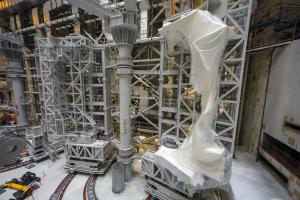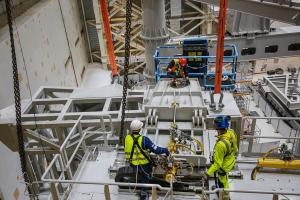Thermal shield passes first trial
In the oversized world of ITER, the 11-metre-tall vacuum vessel thermal shield panels are lightweight components. At approximately 10 tonnes, they cannot compare with a vacuum vessel sector or a coil, which tip the scale at several hundred tonnes. Lighter, however, does not mean easier to install. On the contrary—light and tall means relatively flexible and likely to incur deformations if not handled properly. Maintaining the component's nominal shape throughout the installation sequence requires an exceptionally sturdy frame, a dozen attachment points and ultra-precise metrology.
Positioning the outboard panel inside its 30-tonne frame and precisely adjusting the clamps to 13 attachment points to keep the component from deviating from its nominal shape had required a full week's work. Moving it from one end of the Assembly Hall to the tool at the other took another 12 hours.
By the end of December, the component will have company. In a similar sequence, the second (left hand) outboard panel will be installed on the opposite "wing" of the tool, where it will remain for about a month. The outboard right-hand panel will then be removed and replaced by the inboard component.
Holding one of each type of panel in its arms, the SSAT will be ready to perform the first pre-assembly sequence—the rotation of the inboard section into place. This will be the initial act of the first vacuum vessel sector pre-assembly operation. In addition to the thermal shield panels, two toroidal field coils will be rotated and attached to vacuum vessel sector #6.
The operation, one of the most delicate and challenging of the whole ITER assembly, will need to be repeated nine times to form the doughnut-shaped fusion chamber surrounded by 18 toroidal field coils.
The elements for the first 1,200-tonne pre-assembly are now all on hand: the thermal shield panels began arriving in the fall of 2019, vacuum vessel sector #6 was delivered by Korea on 7 August, and toroidal field coils #12 and #13 arrived on site on 25 April and 3 July respectively.



